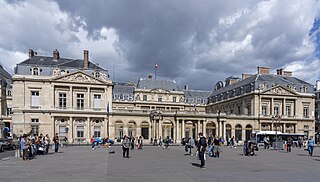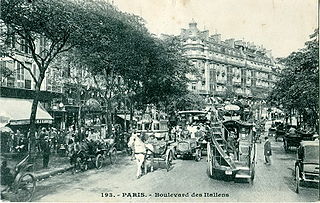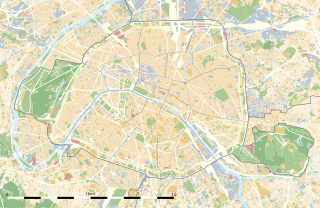
The Palais Bourbon serves as a meeting place of the French National Assembly, the lower legislative chamber of the French government. It is located in the 7th arrondissement of Paris, on the left bank of the Seine, across from the Place de la Concorde.

The Luxembourg Palace is located at 15 Rue de Vaugirard in the 6th arrondissement of Paris. It was originally built (1615–1645) to the designs of the French architect Salomon de Brosse to be the royal residence of the regent Marie de' Medici, mother of King Louis XIII. After the Revolution it was refashioned (1799–1805) by Jean Chalgrin into a legislative building and subsequently greatly enlarged and remodeled (1835–1856) by Alphonse de Gisors. Since 1958 it has been the seat of the Senate of the Fifth Republic.

The Palais-Royal, originally called the Palais-Cardinal, is a former royal palace located in the 1st arrondissement of Paris, France. The screened entrance court faces the Place du Palais-Royal, opposite the Louvre. In 1830 the larger inner courtyard of the palace, the Cour d'Honneur, was enclosed to the north by what was probably the most famous of Paris's covered arcades, the Galerie d'Orléans. Demolished in the 1930s, its flanking rows of columns still stand between the Cour d'Honneur and the popular Palais-Royal Gardens.

The 4th House of Orléans, sometimes called the House of Bourbon-Orléans to distinguish it, is the fourth holder of a surname previously used by several branches of the Royal House of France, all descended in the legitimate male line from the dynasty's founder, Hugh Capet. The house was founded by Philippe I, Duke of Orléans, younger son of Louis XIII and younger brother of Louis XIV, the "Sun King".

The following is a timeline of the history of the city of Paris, France.

Louise Marie Adélaïde de Bourbon-Penthièvre, Duchess of Orléans, was the daughter of Louis Jean Marie de Bourbon, Duke of Penthièvre and of Princess Maria Theresa Felicitas of Modena. At the death of her brother, Louis Alexandre de Bourbon-Penthièvre, prince de Lamballe, she became the wealthiest heiress in France prior to the French Revolution. She married Louis Philippe II, Duke of Orléans, the "regicide" Philippe Égalité, and was the mother of France's last king, Louis Philippe I, King of the French. She was sister-in-law to the princesse de Lamballe, and was the last member of the Bourbon-Penthièvre family.

The Pavillon de Flore, part of the Palais du Louvre in Paris, France, stands at the southwest end of the Louvre, near the Pont Royal. It was originally constructed in 1607–1610, during the reign of Henry IV, as the corner pavilion between the Tuileries Palace to the north and the Louvre's Grande Galerie to the east. The pavilion was entirely redesigned and rebuilt by Hector Lefuel in 1864–1868 in a highly decorated Napoleon III style. The most famous sculpture on the exterior of the Louvre, Jean-Baptiste Carpeaux's The Triumph of Flora, was added below the central pediment of the south facade at this time. The Tuileries Palace was burned by the Paris Commune in 1871, and a north facade, similar to the south facade, was added to the pavilion by Lefuel in 1874–1879. Currently, the Pavillon de Flore is part of the Musée du Louvre.

Marie de Bourbon, Duchess of Montpensier, and Duchess of Orléans by marriage, was a French noblewoman and one of the last members of the House of Bourbon-Montpensier. Her parents were Henri de Bourbon, Duke of Montpensier and Henriette Catherine de Joyeuse, Duchess of Joyeuse in her own right.

The Théâtre du Palais-Royal is a 750-seat Parisian theatre at 38 rue de Montpensier, located at the northwest corner of the Palais-Royal in the Galerie de Montpensier at its intersection with the Galerie de Beaujolais.

The Musée national des Monuments Français is today a museum of plaster casts of French monuments located in the Palais de Chaillot, 1, place du Trocadéro et du 11 Novembre, Paris, France. It now forms part of the Cité de l'Architecture et du Patrimoine, and is open daily except Tuesday. An admission fee is charged.

The boulevard des Italiens is a boulevard in Paris. It is one of the 'Grands Boulevards' in Paris, a chain of boulevards built through the former course of the Wall of Charles V and the Louis XIII Wall, which were destroyed by the orders of Louis XIV. The origin of the name is the théâtre des Italiens built on it in 1783, shortly before the French Revolution on the site now occupied by the third Salle Favart.

Jules Alphonse Ernest Renoux was a French painter working during the height of French Impressionism and the Belle Epoque.

The Galerie Véro-Dodat is one of the covered passages of Paris. It is located in the 1st arrondissement, connecting the Rue de Jean-Jacques Rousseau and Rue de Croix-des-Petits-Champs. It was built in 1826.

The Rue Rambuteau is a street in Paris, France, named after the Count de Rambuteau who started the widening of the road prior to Haussmann's renovation of Paris. The philosopher Henri Lefebvre lived on the street and observed from his window the rhythms of everyday life at the intersection located behind the Centre Georges Pompidou.

During the Restoration of the Bourbon monarchy (1815–1830) that followed the downfall of Napoleon, Paris was ruled by a royal government which tried to reverse many of the changes made to the city during the French Revolution. The city grew in population from 713,966 in 1817 to 785,866 in 1831. During the period Parisians saw the first public transport system, the first gas street lights, and the first uniformed Paris policemen. In July 1830, a popular uprising in the streets of Paris brought down the Bourbon monarchy and began reign of a constitutional monarch, Louis-Philippe.

Paris during the reign of King Louis-Philippe (1830-1848) was the city described in the novels of Honoré de Balzac and Victor Hugo. Its population increased from 785,000 in 1831 to 1,053,000 in 1848, as the city grew to the north and west, while the poorest neighborhoods in the center became even more crowded.

Charles Oudin is one of the oldest French horology firms. It was founded in Paris at the end of the 18th century by Jean-Charles Oudin, who came from a family of clockmakers in Northwest France. There were four generations of Oudins who were clockmakers, as of the mid 18th century, first in the Meuse region and later, in Paris. Several members of the Oudin family worked for the master watch and clockmaker Abraham-Louis Breguet.
The style of architecture and design under King Louis Philippe I (1830–1848) was a more eclectic development of French neoclassicism, incorporating elements of neo-Gothic and other styles. It was the first French decorative style imposed not by royalty, but by the tastes of the growing French upper class. In painting, neoclassicism and romanticism contended to become the dominant style. In literature and music, France had a golden age, as the home of Frédéric Chopin, Franz Liszt, Victor Hugo, Honoré de Balzac, and other major poets and artists.

Rue Beaujolais is a street in the 1st arrondissement of Paris, France.

Rue de Valois is a street in the Palais-Royal quarter in the 1st arrondissement of Paris, France.





















